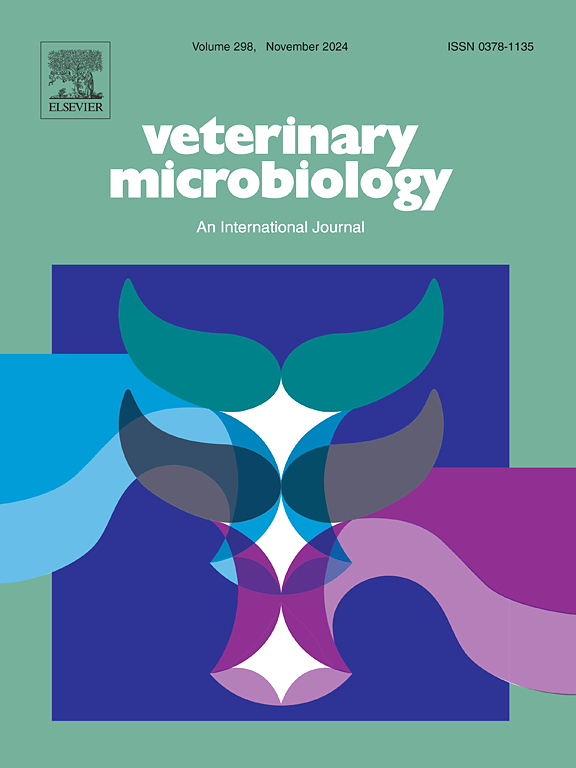自噬参与鼠伤寒沙门氏菌诱导的巨噬细胞铁下垂
IF 2.7
2区 农林科学
Q3 MICROBIOLOGY
引用次数: 0
摘要
沙门氏菌是最常见的人畜共患病原体之一,对动物和人类健康都构成重大威胁。我们之前的研究表明,自噬在限制沙门氏菌的细胞内生长中起着至关重要的作用。本研究旨在探讨自噬对鼠伤寒沙门菌(S. Typhimurium)诱导的铁下垂的影响。首先,我们发现鼠伤寒沙门氏菌通过增加细胞内Fe2 +水平、促进脂质氧化和抑制抗氧化途径诱导脂质过氧化。鼠伤寒沙门氏菌诱导的脂质过氧化导致巨噬细胞铁下垂。进一步的研究结果表明,鼠伤寒沙门氏菌通过ncoa4介导的铁蛋白自噬引发铁蛋白降解。此外,鼠伤寒沙门氏菌诱导的伴侣介导的自噬(CMA)通过TAK1-HSC70信号通路降解GPX4。值得注意的是,GPX4参与胞内鼠伤寒沙门氏菌的释放。综上所述,自噬对鼠伤寒沙门氏菌诱导的铁死亡至关重要,TAK1不仅促进自噬消除细胞内细菌,而且促进细菌释放。本文章由计算机程序翻译,如有差异,请以英文原文为准。
Autophagy is involved in Salmonella Typhimurium-induced ferroptosis in macrophages
Salmonella is one of the most common zoonotic pathogens, posing a significant threat to both animal and human health. Our previous study demonstrated that autophagy plays a crucial role in restricting the intracellular growth of Salmonella. This study aims to investigate the effect of autophagy in Salmonella Typhimurium (S. Typhimurium)-induced ferroptosis. First, we found that S. Typhimurium induced lipid peroxidation by increasing intracellular Fe2 + levels, promoting lipid oxidation, and inhibiting the antioxidant pathway. S. Typhimurium-induced lipid peroxidation led to ferroptosis in macrophages. Further results revealed that S. Typhimurium triggered ferritin degradation by NCOA4-mediated ferritinophagy. Additionally, S. Typhimurium-induced chaperone-mediated autophagy (CMA) degraded GPX4 through TAK1-HSC70 signaling pathway. Notably, GPX4 is involved in intracellular S. Typhimurium release. Overall, autophagy was essential for S. Typhimurium induced-ferroptosis, TAK1 not only facilitated autophagy to eliminate intracellular bacteria but also promoted bacterial release.
求助全文
通过发布文献求助,成功后即可免费获取论文全文。
去求助
来源期刊

Veterinary microbiology
农林科学-兽医学
CiteScore
5.90
自引率
6.10%
发文量
221
审稿时长
52 days
期刊介绍:
Veterinary Microbiology is concerned with microbial (bacterial, fungal, viral) diseases of domesticated vertebrate animals (livestock, companion animals, fur-bearing animals, game, poultry, fish) that supply food, other useful products or companionship. In addition, Microbial diseases of wild animals living in captivity, or as members of the feral fauna will also be considered if the infections are of interest because of their interrelation with humans (zoonoses) and/or domestic animals. Studies of antimicrobial resistance are also included, provided that the results represent a substantial advance in knowledge. Authors are strongly encouraged to read - prior to submission - the Editorials (''Scope or cope'' and ''Scope or cope II'') published previously in the journal. The Editors reserve the right to suggest submission to another journal for those papers which they feel would be more appropriate for consideration by that journal.
Original research papers of high quality and novelty on aspects of control, host response, molecular biology, pathogenesis, prevention, and treatment of microbial diseases of animals are published. Papers dealing primarily with immunology, epidemiology, molecular biology and antiviral or microbial agents will only be considered if they demonstrate a clear impact on a disease. Papers focusing solely on diagnostic techniques (such as another PCR protocol or ELISA) will not be published - focus should be on a microorganism and not on a particular technique. Papers only reporting microbial sequences, transcriptomics data, or proteomics data will not be considered unless the results represent a substantial advance in knowledge.
Drug trial papers will be considered if they have general application or significance. Papers on the identification of microorganisms will also be considered, but detailed taxonomic studies do not fall within the scope of the journal. Case reports will not be published, unless they have general application or contain novel aspects. Papers of geographically limited interest, which repeat what had been established elsewhere will not be considered. The readership of the journal is global.
 求助内容:
求助内容: 应助结果提醒方式:
应助结果提醒方式:


